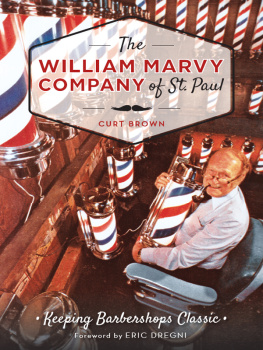
Published by The History Press
Charleston, SC 29403
www.historypress.net
Copyright 2015 by Curt Brown
All rights reserved
Front cover: Photograph by Annie Griffiths and reprinted with permission of the National Geographic Society.
First published 2015
e-book edition 2015
ISBN 978.1.62585.099.7
Library of Congress Control Number: 2014953430
print edition ISBN 978.1.62619.569.1
Notice: The information in this book is true and complete to the best of our knowledge. It is offered without guarantee on the part of the author or The History Press. The author and The History Press disclaim all liability in connection with the use of this book.
All rights reserved. No part of this book may be reproduced or transmitted in any form whatsoever without prior written permission from the publisher except in the case of brief quotations embodied in critical articles and reviews.
CONTENTS
FOREWORD
How many times did I drive by the Marvy Company on St. Clair Avenue in St. Paul and not realize what history hid behind those doors? The brick building is an old auto repair shop and seemed like an odd place for a barbershop. I thought even the name Marvy was a trumped-up synonym for marvelous rather than the real name of William Marvy, who founded the shop to sell the last barber poles in the country. Only when I dared enter did I learn a bit of the history that Curt Brown has uncovered in-depth with his research for this book.
Inside, I learned how the haircutting biz has been cleaned up from the days when barbers doubled as doctors to lance boils, yank teeth and even bleed patients with leeches. The rags to sop up the extra blood were hung outside to dry. As the cloths spun into a spiral in the wind, they served as an advertisement for the services offered insideeven better than the ditty shave and a haircuttwo bits. Marvys modern barber poles cleaned up this image and saved it from oblivion by making it six ways better than the pass poles of yore.
So sit back and enjoy the story about the preservation of this great symbol of the barber pole that stems back to medieval times.
ERIC DREGNI
Author of In Cod We Trust: Living the Norwegian Dream, Minnesota Marvels: Roadside Attractions in the Land of Lakes and seven other books
ACKNOWLEDGMENTS
I first walked into the William Marvy Companys brick vortex in St. Paul in 1997, reporting on a business story for the Minneapolis Star Tribune. Sadly, William had passed away four years earlier.
But his son Robert and grandsons Scott and Dan have been kind enough to trust me with their methodically preserved family archives: from William Marvys teenage diaries to the companys ledger books and the secrets cradled on every line. Their cooperation was instrumental in telling their patriarchs story, as was Rimon, the Minnesota Jewish Arts Council. The arts-supporting panel of the Minneapolis Jewish Federation helped this Jewish writer expand his chops and share a quintessential tale of Minnesota Jewish chutzpah.
Im also indebted to Marvy barber pole makers Scott Gohr and Chue Vang; fellow chronicler of the offbeat tale Eric Dregni; Macalester College professor of history Dr. Norm Rosenberg, who lent me his copy of Mic Hunters delightful The American Barbershop: A Closer Look at a Disappearing Place; Donald Katzs peerless history on the second half of the twentieth century, Home Fires; research aides and dear friends Richard Fohrman, Bill McAuliffe, David Reitan and Bill Sands; Howard Warner, executive director of the Ohio Barbers Board, who created the Barber Hall of Fames online biographies; Barber Car maker Joe Bailon and his great-nephew Ray Olivas; the National Barber Hall of Fame Kirkpatricks, Ken Kirkpatrick in Minnesota and Charles Kirkpatrick in Arkansas; and their countless fellow barbers from Boston to Los Angeles who visited with a curious writer who became an obsessive barber pole chaser: Jim Stroh in Tomah, Wisconsin; Ray Opatz in St. Cloud, Minnesota; Robert Layne and Leroy Young in Chicago; Gilbert Peppin in St. Paul; Peggy Schmidt and Kelly Sharp in Minneapolis; Aneury J. Brito near Boston; Carlos Jimenez near Los Angeles; Rob Petrie in Telluride and Merv Bergal and Amador Tucson in Durango, Colorado; father and son Clyde and Mark Schafer near Tampa and Toledo, respectively; Brian Franke in New Hope, Minnesota; Barber Hall of Fame director Mike Ippoliti near Columbus, Ohio; and the irrepressible immigrant from Hartford, Connecticut, via Minnesota and Kosovo, Nazim (Noli) Salihu. Finally, special shout-outs go to Anita Duquette at the Whitney Museum; Greg Dumais and Julia Turner at The History Press; my daughter, Mackenzie, for searching for serial numbers in California; and my wife, Adele, for joining me on this quirky journey.
INTRODUCTION
You went up a long lane through groves to find it. When you stepped out and walked through the door, your short article turned into a book.
John McPhee, Oranges, 1966
I descend rickety wooden stairsmore like a haphazard cascade of weathered boards held together with a few rusty nails. There are no handrails.
The basement is dark and has a dirt floor. Brick pavers and limestone jut out from mud walls as they have since the 1880s.
So many brick chunks have loosened and fallen that theres a pile in front of me as I step off the last plank of stairs. I gingerly tiptoe around them and illuminate the darkness with my cellphones greenish glow.
According to Jim Stroh, whose barbershop is bustling above in Tomah, Wisconsin, the ladder should be at the bottom of the stairs. Its not.
The darkness eases as my eyes adjust. I see a bent, aluminum ladder at the basements far end. I inch ahead amid fallen rock, sure a rat will crawl up my pant leg any second. I grab the ladder, balancing it precariously as I make my way up the stairs and into the Saturday morning swirl of Strohs Barbershop.
A couple of old-timers wait, watching an outdoors hunting show on a TV mounted high on the wall beside stuffed deer heads. A father, his five-year-old son perched on his lap, chats as Jim cuts the kids bangs.
They all look at me quizzically as I weave through the shop, dodging mirrors and patrons before waltzing my way out the front door.
I plant the ladder next to the entrance of Strohs Barbershop on the corner of Superior Avenue and Monowa Street, in the heart of downtown Tomahif not the heart of America. The surrounding storefronts include the Crow Bar, Teepee Supper Club, High Guns and Firearms, Egstad Insurance & Inspection, Marilyns School of Dance, Amish Country Corner, a variety store and a tattoo parlor.
I climb four steps up the ladder until Im face-to-face with the two-pronged target of this quixotic journey. The doorway into Strohs Barbershop is framed by not one but two Marvy Model 55 barber poles. Like the other eighty-five thousand Marvy barber poles made since 1950, these two aluminum and stainless steel iconic symbols feature rounded and reflective bowls up top and on the bottom that serve as caps and bases for the tubular glass cylinders housing the swirling red, white and blue diagonally spinning stripes.
The Marvy barber pole is a nostalgic survivor, still made by hand in a nondescript brick factory in St. Paul, Minnesotacreations of one of those quirky family businesses that started in the middle of the last century and today finds itself in a club of endangered species like the Javan rhinoceros and the ivory-billed woodpecker.
The William Marvy Company is the last manufacturer of barber poles in the Americasnorth, central and south. Japan, China and Europe continue to crank out a few poles. But Marvy remains the king. Odds are, if you catch a glimpse of a barber pole on Main Streets in small-town America or in the heart of its big cities, its a Marvy.
Next page











